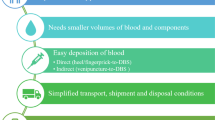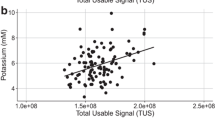Abstract
Dried blood spot (DBS) samples are already successfully used in newborn screening and pharmacological analyses. The application of DBS matrix to further metabolomic methods will considerably extend the analytical options for the diagnostics of metabolic diseases. We present an MS/MS based method for the simultaneous extraction and quantification of 188 metabolites from dried blood spots. We provide a sensitive and reproducible method that adapts the AbsoluteIDQ™ p180 kit of Biocrates to the DBS matrix for the quantification of metabolites of different substance classes including amino acids, biogenic amines, free carnitine, acylcarnitines, hexoses, glycerophospholipids, lysophosphatidylcholines, phosphatidylcholines, and sphingolipids.



Similar content being viewed by others
References
Ceglarek U, Müller P, Stach B, Bührdel P, Thiery J, Kiess W (2002) Validation of the phenylalanine/tyrosine ratio determined by tandem mass spectrometry: sensitive newborn screening for phenylketonuria. Clin Chem Lab Med 40(7):693–697
Rashed MS (2001) Clinical applications of tandem mass spectrometry: ten years of diagnosis and screening for inherited metabolic diseases. J Chromatogr B Biomed Sci Appl 758(1):27–48
Déglon J, Thomas A, Mangin P, Staub C (2012) Direct analysis of dried blood spots coupled with mass spectrometry: concepts and biomedical applications. Anal Bioanal Chem 402(8):2485–2498
Leichtle AB, Ceglarek U, Witzigmann H, Thiery J, Fiedler GM (2010) Potential of dried blood self-sampling for cyclosporine C 2 monitoring in transplant outpatients. J Transplant. doi:10.1155/2010/201918
Barfield M, Spooner N, Lad R, Parry S, Fowles S (2008) Application of dried blood spots combined with HPLC-MS/MS for the quantification of acetaminophen in toxicokinetic studies. J Chromatogr B 870(1):32–37
Spooner N, Lad R, Barfield M (2009) Dried blood spots as a sample collection technique for the determination of pharmacokinetics in clinical studies: considerations for the validation of a quantitative bioanalytical method. Anal Chem 81(4):1557–1563
Möller I, Thomas A, Geyer H, Schänzer W, Thevis M (2012) Development and validation of a mass spectrometric detection method of peginesatide in dried blood spots for sports drug testing. Anal Bioanal Chem 403(9):2715–2724
Michopoulos F, Lai L, Gika H, Theodoridis G, Wilson I (2009) UPLC-MS-based analysis of human plasma for metabonomics using solvent precipitation or solid phase extraction. J Proteome Res 8(4):2114–2121
McDade TW, Williams S, Snodgrass JJ (2007) What a drop can do: dried blood spots as a minimally invasive method for integrating biomarkers into population-based research. Demography 44(4):899–925
Illig T, Gieger C, Zhai G, Römisch-Margl W, Wang-Sattler R, Prehn C, Altmaier E, Kastenmüller G, Kato BS, Mewes HW (2009) A genome-wide perspective of genetic variation in human metabolism. Nat Genet 42(2):137–141
Gonçalves I, Edsfeldt A, Ko NY, Grufman H, Berg K, Björkbacka H, Nitulescu M, Persson A, Nilsson M, Prehn C (2012) Evidence supporting a key role of Lp-PLA2-generated lysophosphatidylcholine in human atherosclerotic plaque inflammation. Arterioscler Thromb Vasc Biol 32(6):1505–1512
Renner S, Römisch-Margl W, Prehn C, Krebs S, Adamski J, Göke B, Blum H, Suhre K, Roscher AA, Wolf E (2012) Changing metabolic signatures of amino acids and lipids during the prediabetic period in a pig model with impaired incretin function and reduced β-cell mass. Diabetes 61(8):2166–2175
Vouk K, Hevir N, Ribič-Pucelj M, Haarpaintner G, Scherb H, Osredkar J, Möller G, Prehn C, Rižner TL, Adamski J (2012) Discovery of phosphatidylcholines and sphingomyelins as biomarkers for ovarian endometriosis. Hum Reprod 27(10):2955–2965
Römisch-Margl W, Prehn C, Bogumil R, Röhring C, Suhre K, Adamski J (2012) Procedure for tissue sample preparation and metabolite extraction for high-throughput targeted metabolomics. Metabolomics 8(1):133–142
Jourdan C, Petersen AK, Gieger C, Döring A, Illig T, Wang-Sattler R, Meisinger C, Peters A, Adamski J, Prehn C (2012) Body fat free mass is associated with the serum metabolite profile in a population-based study. PLoS One 7(6):e40009
RDevelopment C (2012) TEAM (2008): R: A language and environment for statistical computing. Vienna, Austria. Internet: http://www.R-project.org. Accessed 10.10. 2012
Kastenmüller G, Römisch-Margl W, Wägele B, Altmaier E, Suhre K (2011) metaP-server: a web-based metabolomics data analysis tool. J Biomed Biotechnol 2011. doi:10.1155/2011/839862
Guidance for Industry. Bioanalytical method validation. US Department of Health and Human Services, Food and Drug Administration, 2001
Shah VP, Midha KK, Findlay JWA, Hill HM, Hulse JD, McGilveray IJ, McKay G, Miller KJ, Patnaik RN, Powell ML (2000) Bioanalytical method validation—a revisit with a decade of progress. Pharm Res 17(12):1551–1557
Brauer R, Leichtle AB, Fiedler GM, Thiery J, Ceglarek U (2011) Preanalytical standardization of amino acid and acylcarnitine metabolite profiling in human blood using tandem mass spectrometry. Metabolomics 7(3):344–352
Mei JV, Alexander JR, Adam BW, Hannon WH (2001) Use of filter paper for the collection and analysis of human whole blood specimens. J Nutr 131(5):1631S–1636S
Holub M, Tuschl K, Ratschmann R, Strnadová KA, Mühl A, Heinze G, Sperl W, Bodamer OA (2006) Influence of hematocrit and localisation of punch in dried blood spots on levels of amino acids and acylcarnitines measured by tandem mass spectrometry. Clin Chim Acta 373(1):27–31
Van Eeckhaut A, Lanckmans K, Sarre S, Smolders I, Michotte Y (2009) Validation of bioanalytical LC-MS/MS assays: evaluation of matrix effects. J Chromatogr B 877(23):2198–2207
Chambers E, Wagrowski-Diehl DM, Lu Z, Mazzeo JR (2007) Systematic and comprehensive strategy for reducing matrix effects in LC/MS/MS analyses. J Chromatogr B 852(1–2):22–34
Rogatsky E, Stein D (2005) Evaluation of matrix effect and chromatography efficiency: new parameters for validation of method development. J Am Soc Mass Spectrom 16(11):1757–1759
Identifying inherited metabolic disorders using the API 3200 LC/MS/MS system (2006). Application note, Applied biosystems 114AP54-01
Bell JG, Mackinlay EE, Dick JR, Younger I, Lands B, Gilhooly T (2011) Using a fingertip whole blood sample for rapid fatty acid measurement: method validation and correlation with erythrocyte polar lipid compositions in UK subjects. Br J Nutr 106(9):1408
Chace DH, Adam BW, Smith SJ, Alexander JR, Hillman SL, Hannon WH (1999) Validation of accuracy-based amino acid reference materials in dried-blood spots by tandem mass spectrometry for newborn screening assays. Clin Chem 45(8):1269–1277
Strnadová KA, Holub M, Mühl A, Heinze G, Ratschmann R, Mascher H, Stöckler-Ipsiroglu S, Waldhauser F, Votava F, Lebl J (2007) Long-term stability of amino acids and acylcarnitines in dried blood spots. Clin Chem 53(4):717–722
Madira W, Xavier F, Stern J, Wilcox A, Barron J (1992) Determination and assessment of the stability of phenylalanine and tyrosine in blood spots by HPLC. Clin Chem 38(10):2162–2163
Acknowledgments
We thank Julia Scarpa, Katharina Sckell, Werner Römisch-Margl, and Andrea Nefzger for metabolomics measurements performed at the Helmholtz Zentrum München, Genome Analysis Center, Metabolomics Core Facility. This study was supported in part by a grant from the German Federal Ministry of Education and Research (BMBF) to the German Center Diabetes Research (DZD e.V.).
Author information
Authors and Affiliations
Corresponding author
Additional information
Published in the topical collection Miniaturized and New Featured Planar Chromatography and Related Techniques with guest editor Paweł K. Zarzycki.
Electronic supplementary material
Below is the link to the electronic supplementary material.
Rights and permissions
About this article
Cite this article
Zukunft, S., Sorgenfrei, M., Prehn, C. et al. Targeted Metabolomics of Dried Blood Spot Extracts. Chromatographia 76, 1295–1305 (2013). https://doi.org/10.1007/s10337-013-2429-3
Received:
Revised:
Accepted:
Published:
Issue Date:
DOI: https://doi.org/10.1007/s10337-013-2429-3




